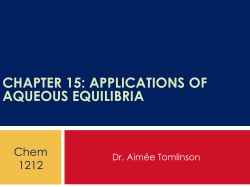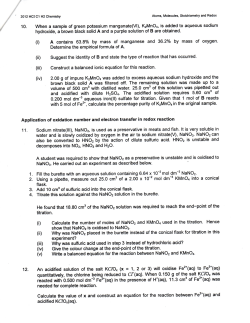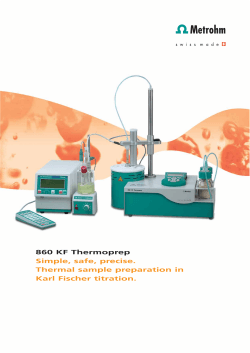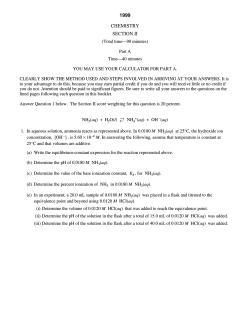
A Volumetric Analysis (Back-Titration) of the Active Ingredient in an Antacid
CHEM 311L Revision 2.3 A Volumetric Analysis (Back-Titration) of the Active Ingredient in an Antacid In this laboratory exercise, we will determine the amount of weak base present in an Antacid tablet; it is the weak base which provides relief of excess stomach acid and is considered the active ingredient. However, a direct Acid-Base titration of the weak base is not possible because of the slow nature of the Titration Reaction. Therefore, we will perform a Back Titration analysis instead. In many cases where a Volumetric Analysis is required, the Titration Reaction is slow to go to completion. Or, the titration Endpoint is not sharp. Or, the Standard Solution is not stable. In these cases, a Back Titration may be useful. In a Back Titration, an excess of Standard Solution is added to the Analyte Solution. The excess Standard is then back-titrated with a second Standard Solution. In most cases, because fewer errors occur, a direct titration is preferred. However, when one of the above conditions exists, a back-titration may be the only practical option for carrying-out the analysis. We will perform our analysis on one of the following Antacids: Antacid Tums Milk of Magnesia Alka-Seltzer Weak Base CaCO3 Mg(OH)2 NaHCO3 The reaction between the weak base of the Antacid and an acidic standard is problematic. Many antacids do not readily dissolve in water or they react somewhat slowly with acids. So, a back titration procedure is called for. An excess of Standard HCl is added to the sample and the mixture is heated to ensure a complete and timely reaction. Weak Base + HCl(aq) Salt of the Weak Base + H2O (Eq. 1) The excess acid is then titrated with Standard NaOH: P age |2 HCl(aq) + NaOH(aq) NaCl(aq) + H2O (Eq. 2) In this case, because two Standard Solutions are required, NaOH and HCl, two Standardizations will have to be performed. The NaOH solution can be Standardized against Potassium Hydrogen Phthalate (KHC8H4O4, abrv. KHP, MW = 204.221 g/mole), a good Primary Standard: HC8H4O4-(aq) + OH-(aq) C8H4O42-(aq) + H2O (Eq. 3) (KHP) The resulting Standard NaOH solution can then be used as a Secondary Standard to Standardize the HCl solution. HCl(aq) + NaOH(aq) NaCl(aq) + H2O (Eq. 4) Both the Sodium Hydroxide and Hydrochloric Acid Standard Solutions are referred to as Secondary Standard Solutions because their concentrations are determined by performing a P age |3 Standardization Analysis. (A Primary Standard Solution is one which is prepared by directly weighing out a Primary Standard and then diluting it in solution to a known volume.) Thus, we will prepare a solution of the desired Antacid. This will be treated with an excess of Standard HCl solution. Once the reaction between the active ingredient of the Antacid and the HCl is complete, the excess acid will be titrated with a Standard NaOH solution. All of the usual precautions regarding an acid-base titration using Sodium Hydroxide must be observed. P age |4 Pre-Lab Calculations 1. Write chemical reactions for the reaction of the active ingredient of each of the Antacids listed above with aqueous HCl. 2. Determine the volume of Conc. HCl required to prepare 500mL of 0.30M solution. 3. 1.2511g of crushed Limestone was added to 50.0 mL of 1.019 M HCl solution. CaCO3(s) + 2 HCl(aq) CO2(g) + H2O + CaCl2(aq) After the solution ceased bubbling, it was heated to drive off any additional CO2 and to drive the reaction to completion. After cooling, the solution was diluted to 250 mL in a class A volumetric flask. A 25.0 mL aliquot of this solution was then titrated to a Methyl Orange endpoint using 28.52 mL of 0.1015 M NaOH. What is the percentage Calcium Carbonate in the Limestone sample? P age |5 Procedure Standardization of the NaOH Titrant Boil 1 L of Deionized Water for about 5 minutes to remove dissolved Carbon Dioxide. Allow the Water to cool covered by a watch glass. Transfer while warm to a 1 L bottle. (Never store strong bases in glass containers as they will react with the glass, changing the concentration of the base and etching the container. Transfer between 7 and 8 mL of a 50% Sodium Hydroxide solution to the bottle of Water using a 10 mL graduated cylinder. Mix thoroughly and keep capped. Many students may find that they obtain more consistent results if they shake the bottle vigorously before each time they refill their burette. Dry 4-5g of Primary Standard KHP in a weighing bottle at 110oC for at least one hour. Cool for 30 minutes in a desiccator. Weigh, to the nearest 0.1 mg, 3 ~0.6g samples of the dry KHP into separate 250 mL Erlenmeyer flasks and dissolve in 50 mL distilled water. Warm the solutions to promote dissolution of the KHP if needed. Titrate to a Phenolphthalein endpoint using the NaOH titranat solution. Calculate the molarity of the NaOH solution for each trial. Calculate the average and standard deviation of these values. Standardization of the HCl Titrant Prepare 500mL of ~1.0M HCl. Standardize against the NaOH Standard using a Phenolphthalein indicator. Perform the Standardization in triplicate. Calculate the molarity of the HCl solution for each trial. Calculate the average and standard deviation of these values. Back Titration of the Antacid Alternative 1 Obtain one of the Tums Extra Strength Antacid tablets and weigh it. Make note of information concerning the active ingredients. (Light/White colored tablets work best.) Now crush it with a mortar and pestel, transfer the powder to a tared weigh boat and reweigh the boat. Transfer the crushed sample to an Erlenmeyer flask and reweigh the weigh boat. Or Alternative 2 Obtain 7.5 mL of Kroger brand Milk of Magnesia using a graduated cylinder. Make note of information concerning the active ingredients. Transfer the Milk of Magnesia quantitatively to an Erlenmeyer Flask. Add approximately 50 mL of Water. P age |6 Now, pipet in 25 mL of the Standardized HCl solution. Rinse down the sides of the flask with a little water. If using the Tums antacid, heat the flask to boiling for about 2 minutes to speed up the reaction and to drive off any CO2. Cool the flask to Room Temperature; ~10 minutes. Add 10 drops Phenolphthalein indicator to the solution. Titrate the solution to the faint pink endpoint. Repeat the procedure for a triplicate analysis. Calculate the number of milligrams active ingredient. Scale your result so that your analysis is consistent with the product label. P age |7 Appendix - Acid-Base Indicators Indicator Thymol Blue Methyl Orange Congo Red Methyl Red Bromocresol Purple Bromthymol Blue Cresol Red Thymol Blue Phenolphthalein Alizarin Yellow Range 1.2 – 2.8 3.1 – 4.4 3.0 – 5.0 4.8 – 6.0 5.2 – 6.8 6.0 – 7.6 7.2 – 8.8 8.0 – 9.6 8.0 – 9.6 10.1 – 12.0 Low pH Color Red Red Purple Red Yellow Yellow Orange Yellow Clear Red High pH Color Orange Yellow Red Yellow Purple Blue Red Blue Pink Purple
© Copyright 2025





















